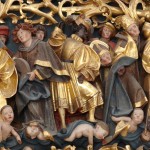 Sculptural Mobilities : tracing the flows of sculptural artworks between the Nordic Countries and Europe from the early modern period to the present day is a one-day symposium organised collaboratively by University College London’s Department of Scandinavian Studies, and Kingston University’s Visual and Material Culture Research Centre. This symposium is funded by the Henry Moore Foundation.
Sculptural Mobilities : tracing the flows of sculptural artworks between the Nordic Countries and Europe from the early modern period to the present day is a one-day symposium organised collaboratively by University College London’s Department of Scandinavian Studies, and Kingston University’s Visual and Material Culture Research Centre. This symposium is funded by the Henry Moore Foundation.
The interdisciplinary symposium will investigate the cultural mobility of sculptural artworks. Positioning the Nordic Countries as a contact zone of sculptural exchange, the project will trace the flows of artworks to and from the Nordic Countries and Europe and examine the impacts these flows generate on both local/regional contexts of display and the nature of the sculptural artwork itself. Histories of sculpture within the Nordic region are arguably under-studied and the region’s influence upon and translation of influences from the wider Europe remain insufficiently traced. Our symposium will seek to emphasise the Nordic Countries’ important role as an interstice between the East, West and the North, and to bring to light individual histories of sculptural mobility from the early modern period onwards. We welcome papers uncovering new histories of sculptural mobility and those focused on examples of contemporary practice, which continue the exchange of sculptural artworks and artists between the Nordic Countries and Europe today.
Stephen Greenblatt has defined cultural mobility as ‘the restless process through which texts, images, artefacts, and ideas are moved, disguised, translated, transformed, adapted, and reimagined in the ceaseless, resourceful work of culture.’ The sculptural artwork by contrast is often imagined as static and fixed, stable and immutable. To what extent is the sculptural artwork changed by transcultural recontextualisation ? What is the potential for movement to compel a performative response within the moving object itself – what are the ways in which it is materially made to move via this process of transcultural exchange? Conversely, how do sculptures impact their new contexts of display ? To what extent do moving sculptures confirm or critique the complexity, interdependence and instability of ‘localised’ cultures?
We are interested in examining the movements of specific sculptural artworks between the Nordic Countries and Europe from a range of interdisciplinary perspectives, encompassing the history of art and aesthetics, reception, geography, anthropology, economics, technology, identity and historiography; we hope to bring hidden histories of sculpture to light and to stimulate new research.
Papers may draw upon the following and other, unlisted topics :
- Materiality and immaterial objects and environments
- Shifting landscapes and regional identities
- Curating moving/changing collections
- The relationship of an object to its site/s
- Trajectories and temporalities
- Technological reproducibility and reproduction, travelling copies
- Home and belonging, territorialisation
- Interpretation and reception
- Public and private contexts of display
- Commercial drivers of mobility
- Movement at the meta/macro/micro levels
- Permanence and commemoration
- Space and place
- The motives and agents of sculptural mobility
- Objects’ life-stories/careers
- Exile and nationalism
- Environment and installation
- Construction and destruction
- Continuity and rupture
- Moving image and sound
- Performativity and participation
- The interchange of centres and peripheries of production and consumption
Papers from the symposium may be published in a special issue of the journal Scandinavica. An International Journal of Scandinavian Studies published by Norvik Press and funded by NOP-HS (Joint Committee for Nordic Research Councils in the Humanities and the Social Sciences).
We invite proposals for twenty-minute papers from academics, early career researchers, postdocs and PhD students, artists and curators. Paper abstracts (maximum 300 words) and a short bio (maximum 100 words) should be submitted to Elettra Carbone (elettra.carbone@ucl.ac.uk) and Sara Ayres (S.Ayres@kingston.ac.uk) by March 15 2013.

Leave a Reply
You must be logged in to post a comment.